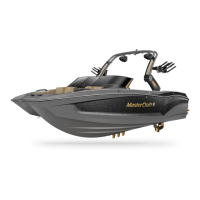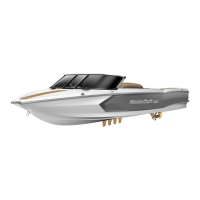Canvas Covers
The material used in constructing Bimini tops and boat covers is
made from 100 percent solution-dyed polyester ber with a urethane
coating to provide excellent water repellency and mildew resistance.
This design allows the material to be easily maintained. By following
a few simple care and cleaning steps, the fabric will continue to look
good and maintain its ne qualities for seasons to come.
Important Background Information
Because the fabrics are woven, they are breathable. It’s also impor-
tant to know that these fabrics are treated with a uorocarbon nish,
which enhances water repellency. This nish requires replenishment
after vigorous cleaning.
Polyester fabric will not support the growth of mildew. Mold and
mildew need something on which to grow and polyester fabric is not
a desirable substance for such growth. Dirt or dust on the fabric,
however, is a perfect source for mildew growth, which makes regular
cleaning of the fabric important.
There is no set time for when the fabric should be cleaned, and
the local environment has a great deal to do with determining cleaning
frequency. Cleaning is required less frequently in a dry environment
than in a humid one where heavy foliage exists.
The material has an applied nish that deters mold and
mildew growth, but it does not make it mold-proof. Keeping
the fabric free of dirt and foreign substances is important in
deterring mold growth.
Cleaning
One of the best ways to keep the material looking fresh and new,
and to delay the need for deep or vigorous cleaning, is to hose off
fabrics with clear water on at least a monthly basis with clean water.
This practice will help prevent dirt from becoming deeply embedded
in the fabric, and it will eliminate the need for more frequent and more
vigorous cleanings.
In most environments, a thorough cleaning will be needed ap-
proximately every two (2) years.
The fabric can be cleaned while still in the boat. When cleaning, it
is important to observe the following:
• Always use a natural soap—never detergent.
• Water should be cold to lukewarm, but never more than 100 de-
grees.
• Air dry only. Never apply heat to the fabric.
Begin by brushing off loose dirt, and then hose down the material.
Prepare a cleaning mixture of water and a mild, natural soap that is free
of detergents. Use a soft-bristle brush to clean, allowing the soap to
soak in. Rinse thoroughly and allow the fabric to thoroughly air dry.
If stubborn stains persist, you can use a diluted chlorine bleach/
soap mixture for spot cleaning of mildew, roof run-off and other simi-
lar stains. Please keep in mind that chlorine bleach will not change the
color of the fabric, but chlorine bleach will eventually break down the
ber of any fabric. Therefore, this cleaning method should be used as
infrequently as possible.
The cleaning mixture should be mixed as follows:
• Four ounces (one-half cup) of chlorine bleach.
• Two ounces (one-fourth cup) of natural soap.
• One gallon of water.
Clean with a soft-bristle brush and allow the mixture to soak no
longer than twenty (20) minutes. Rinse thoroughly and allow to com
-
pletely air dry. Repeat if necessary.
If the top or boat cover is suitable in size for a washing machine,
these steps should be followed:
• Use only natural soaps—no detergent.
• Wash and rinse in cold water.
• Air dry. (Never put the fabric in a dryer.)
As part of the nishing process, the material has been treated with
a uorocarbon nish, which enhances water repellency. This nish is
designed to last for several years, but it must be replenished after
a thorough cleaning. Based on test results, the manufacturer recom-
mends 303 High Tech Fabric Guard™ as the preferred re-treatment
product.
After cleaning and air drying, apply 303 in a thin, even coat. When
it has dried, apply a second thin, even coat. These two (2) light coatings
are more effective in restoring fabric water resistance than a single
heavy coating. Keep in mind that 303 High Tech Fabric Guard™ will
work only as well as it is applied. This means that the fabric must be
free of dirt and detergents or the Fabric Guard will wash away with
the dirt particles.
Fabrics should be retreated after thorough cleaning or after ve
(5) years of use.
Enclosed Head
An option on some models is the enclosed, portable head. This con-
venience should be emptied on-shore within an acceptable holding tank,
septic system or sewer. It should never be emptied within the boating
body of water or on-shore, except in an approved receptacle!
The head should be cleaned after each outing. After thoroughly
cleaning with a mild detergent, add a neutralizing chemical made espe-
cially for portable heads, such as that found in RV centers. The neutral-
izing chemical will help deal with potential odors that might otherwise
be foul.
mastercraft 2010 ow n e r ’s m anual • page 14 -3

